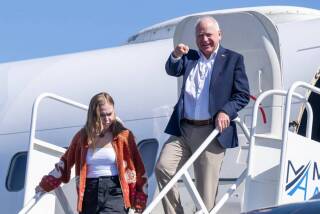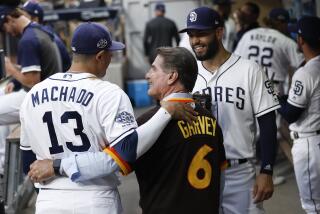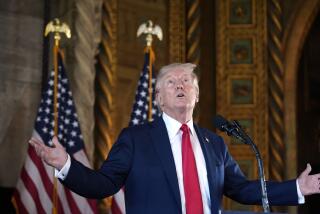Davis Flies Friendly Skies on Private Jets
As he campaigns for reelection, Gov. Gray Davis regularly flies on private jets provided by corporations and labor unions that do business with the state and have a major interest in what happens in Sacramento.
Their willingness to give Davis access to their planes--donations worth thousands of dollars, for which the Davis campaign either pays nothing or a nominal air fare--has allowed the governor to cover more ground and to avoid security delays that have become commonplace at airports during the last year.
A review of the governor’s campaign finance reports by The Times for the last year and a half found that Davis flew on private planes provided by 18 companies, unions or individuals. The reports show that between Jan. 1, 2001, and June 30, 2002, the governor traveled on planes provided by organized labor, water development firm Cadiz Inc., construction contractor Tutor-Saliba Corp., drug maker Eli Lilly & Co. and troubled telecommunications firm Global Crossing Ltd., among others.
“It’s hard to get around the state [on commercial airlines] if you’re doing a multi-city trip and not lose a lot of time at airports,” said Davis campaign spokesman Roger Salazar.
Paying Coach Fares
The governor’s campaign committee paid only a fraction of the cost for that travel--usually no more than the price of a commercial coach airline ticket between the cities involved.
For private plane flights between many points in California, the amount paid by the Davis campaign was often equal to the price of a ticket on Southwest Airlines.
The campaign reports include only the nominal payment by the Davis campaign to a corporation or union. The reports do not indicate the date of travel or the route taken, and the campaign did not provide that information despite requests from The Times.
Davis campaign strategist Garry South said the state Fair Political Practices Commission does not require candidates to disclose the full value of flights on board private planes. Indeed, a 25-year-old opinion by the state’s political watchdog agency says candidates who use corporate airplanes need only report the cost of a commercial airline ticket between the cities involved.
South said donors often provide the planes in response to a request from the campaign.
The low-cost private air transportation represents just one way that well-heeled interests are helping Davis--and, to a much lesser degree, Republican gubernatorial nominee Bill Simon Jr.--in the race for governor of California. Such in-kind contributions come in many forms, from Learjets to lavish receptions, vintage wines to candlelight dinners. They can be as innocuous as buckets of paint or as important as paying the salary of a top campaign strategist. South’s $15,000-a-month salary, for instance, is paid by the state Democratic Party, relieving the Davis campaign of that expense.
Although both candidates make use of in-kind contributions, Davis has relied more heavily on cheap private flights, leading to criticism from the Simon campaign.
“Unfortunately, the average citizen can’t afford a flight on an Air Davis plane,” said Mark Miner, a spokesman for Simon. Miner accused Davis of giving special treatment to the companies and organizations that give him free or cheap transportation.
Salazar, however, denied that Davis gave anything in return for those flights. Just because those companies or others have an interest in state government does not mean that they expect special treatment, he said. Anyone would be “hard-pressed to find any company or entity that doesn’t have business or interests in something to do with the state of California,” Salazar said.
Like cash contributions in the race for the state’s highest office, there is no limit to how much can be given in so-called nonmonetary contributions.
And candidates sometimes manipulate the reported value of such gifts, either to minimize the appearance of influence by a donor or to intimidate rivals by making the campaign appear flush.
In 1998, when Davis was struggling against two well-financed rivals in the Democratic primary, the then-lieutenant governor paid nothing for most of his flights on private jets and instead reported their full value as in-kind contributions from the donors who let him use their planes. He continued that practice throughout the general election campaign against Republican Dan Lungren.
Davis reported the donations that way, South says now, because it highlighted the fact that the campaign was receiving substantial contributions at a time when Davis’ ability to compete against better-funded rivals was in question.
But in the current campaign, Davis and his aides have taken the opposite tack: Having raised more than $50 million since he was elected governor, Davis now usually pays his own way on the flights, but at rates far cheaper than the actual cost of those flights.
During his first run for governor four years ago, Davis relied heavily on a jet provided by Cadiz Inc., a Santa Monica-based firm that is seeking to build a water storage project in the desert. The Davis campaign reported the total value of those flights as nonmonetary contributions worth almost $50,000.
Since then, the Davis campaign has reported only a nominal payment of more than $2,000 to Cadiz for the governor’s occasional use of the company’s jet. As an example, Cadiz provided the company plane for a round trip from Los Angeles to Lake Tahoe in 1999. The Davis campaign paid only $265 for the governor’s special transportation.
The company’s president, Keith Brackpool, is one of Davis’ chief advisors on water issues. Cadiz is pushing a project to store surplus Colorado River water in an aquifer beneath the Mojave Desert for use in dry years.
Cadiz officials did not return repeated phone calls seeking comment about why the company provides a corporate jet to the governor.
Another firm that often supplies planes to Davis is Tutor-Saliba Corp., one of the nation’s biggest construction companies.
Ronald Tutor, president of Tutor-Saliba, said the company jet has been provided to Davis on two or three occasions for flights out of Los Angeles to other cities in the state. The Davis campaign paid Tutor-Saliba $1,049 for the flights.
Tutor said the governor’s office contacts his company and asks if the jet is available. If so, Tutor said, “We let them use the plane.”
The Sylmar-based company was the largest contractor on the Los Angeles subway project and Alameda Corridor linking the ports of Los Angeles and Long Beach with railroad yards near downtown. The company is currently working on major government contracts to upgrade the Richmond-San Rafael Bridge and extend the Bay Area Rapid Transit system to the San Francisco airport.
But Tutor said he makes his plane available to Davis because he appreciates the governor’s work.
“I like the governor,” Tutor said. “I’ve known him for a long time. He’s done a great job as governor.”
Union Provided Plane
Last year, the governor flew on a plane provided by the California Correctional Peace Officers Assn., the union that represents state prison guards. His campaign paid the union, one of Davis’ biggest financial backers, $976 for use of the plane.
Davis signed legislation granting a multimillion-dollar pay raise to members of the union, which last week endorsed his reelection.
Sometimes, Davis accepts private air transportation as a nonmonetary contribution to his campaign, rather than paying the nominal air fare. After election day in the March California primary, for instance, unions representing state firefighters and the building and construction trades joined to underwrite the cost of a plane to shuttle Davis and other Democratic primary winners around the state.
In that instance, the Davis campaign reported an in-kind contribution of $13,000 for one day’s air transportation.
And Monday, when Davis took to the air for his traditional Labor Day fly around California, one of the two jets in his entourage was paid for by labor unions.
All of those unions have a vital stake in what happens in Sacramento--from bread-and-butter negotiations over salaries for state workers to longer-term interests in pension issues, worker safety and development policies.
Although Davis is provided with private planes much more frequently than Simon, the Republican candidate also has taken advantage of the convenience.
When Simon wanted to get maximum mileage out of an endorsement from a law enforcement group in mid-June, for instance, the GOP candidate and his entourage boarded a private jet in Van Nuys. For two days, they crisscrossed the state, flying to Sacramento, Bakersfield, San Diego, Fresno and Oakland.
That trip cost $51,405, according to Simon’s fund-raising reports, and was paid for by Stockton developer Alex G. Spanos.
One of the nation’s biggest housing developers and owner of the San Diego Chargers, Spanos hosted a Simon fund-raiser Aug. 23 at the Stockton airport. President Bush was the special guest at that event.
Spanos supported both Simon and former Los Angeles Mayor Richard Riordan during the long Republican primary campaign, providing both cash contributions and free air transportation on his private plane.
Simon has flown on donated planes several times since he won the Republican nomination. The campaign reports the full value of the flights as in-kind contributions.
Jeffrey P. Bennett, president of Nature’s Recipe Pet Foods, provided a plane to take Simon from Santa Monica to Apple Valley on May 17.
That in-kind contribution was valued at $4,396.
Four days later, Simon flew from Santa Barbara to Sacramento on a plane provided by Fidelity National Financial of Santa Barbara. The firm covered the $2,375 tab for that journey.
Miner, the Simon campaign spokesman, said in some cases the GOP candidate may ask a supporter to provide a private jet. More often, Miner said, Simon flies commercial airlines between the state’s major cities. And in some circumstances, the campaign may charter a plane at its expense.
Whether it’s an in-kind contribution of a private jet or a cash contribution, campaign-finance expert Bob Stern said, “The average voter should be concerned any time money is involved.”
Stern, president of the Los Angeles-based Center for Governmental Studies, said travel on a corporate jet is appreciated by candidates both for its monetary value and its convenience.
“This is clearly a major contribution to the campaign,” he said. “This is worth a lot of money, and the candidates should pay for it,” he said.
One of the authors of the state’s Watergate-era Political Reform Act, Stern said he believes the Fair Political Practices Commission needs to revisit the issue of requiring disclosure of the full value of private air transportation.
The FPPC noted in its 1977 opinion that public officials enjoy “the intangible benefits that ordinarily accompany private air service, such as the added comfort and convenience and avoiding the aggravation that often attends commercial air travel.” But the commission did not and does not require those intangible benefits to be reported. Only the fair market value of the travel must be disclosed.
He noted that the Federal Election Commission requires that federal officials, senators and members of Congress who fly on corporate jets must report the equivalent of the first-class air fare, rather than the coach fare, between the cities involved.
If no commercial air service is available on the route, the FEC requires candidates to report the full cost of a charter flight between the points.
Sigrid Bathen, spokeswoman for the FPPC, defended the state agency’s handling of the private air transportation issue.
“The FPPC has for many years had very clear rules on the reporting of air transportation that all candidates are expected to follow,” she said. “Those rules still apply.”
More to Read
Get the L.A. Times Politics newsletter
Deeply reported insights into legislation, politics and policy from Sacramento, Washington and beyond. In your inbox three times per week.
You may occasionally receive promotional content from the Los Angeles Times.










